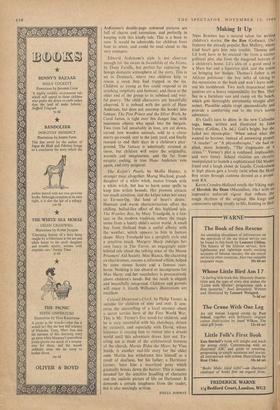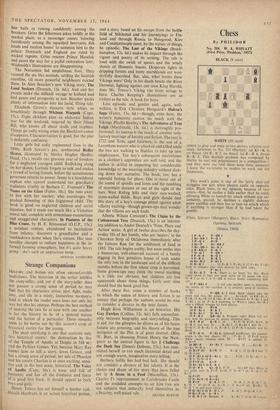Making It Up
NINA BAWDEN has a natural talent for writing children's stories. On the Run (Gollancz, 15s.) features the already popular Ben Mallory, whose kind heart gets him into trouble. Thomas and Lil both have to be rescued—he from a sinister political plot, she from the imagined horrors of a children's home. Lil's idea of a good meal is a Mars bar and a liquorice stick and she insists on bringing her budgie. Thomas's father is an African politician : the boy talks of taking to the mountains or the bush and won't leave with- out his toothbrush. Two such impractical com- panions are a heavy responsibility for Ben. They flee in a furniture van and camp on the beach, which gets thoroughly unromantic straight after sunset. Plausible adults erupt spasmodically and provide a comforting end to the trio's taxing adventure.
It's Gail's turn to shine in the new Caliendo saga, ismo, written and illustrated by John Verney (Collins, 13s. 6d.). Gail's bright, but she failed her eleven-plus : 'When asked what she wanted to become, instead of answering piouslY "A teacher" or "A physiotherapist," she had re- plied, more honestly, "The ringmaster at a circus."' Verney's plot is confused, implausible, and very funny. School rivalries are deverlY manipulated to launch a sophisticated Old Master fraud and a laugh about de Gaulle. Crookedness in high places gets a lovely twist when the Head Boy struts through customs dressed as a promi- nent RA.
• Kevin Crossley-Holland retells the Viking saga of Havelok 'the Dane (Macmillan, 16s.) with an impressive unforced vigour that reflects the rough rhythms of the original. His kings and commoners spring vividly to life, feasting in their fine halls or rowing confidently among the breakers. Grim the fisherman jokes boldly in the market place, as a messenger comes 'mincing fastidiously among the squashed beetroots, fish heads and mutton bones' to summon him to the palace. Denmark and England are ruled by wicked regents. Grim rescues Prince Havelok and paves the way for a joyful restoration later. Wildsmith's illustrations are disappointing.
The Norsemen led amphibious lives. They roamed the sea like nomads, settling the Scottish coastline, till more powerful neighbours evicted them. In Alan Boucher's new Viking story, The .Land Seekers (Deutsch, 13s. 6d,), Aud and her people make the difficult voyage to Iceland and find peace and prosperity at last. Boucher packs plenty of information into his lucid, lilting tale.
Elizabeth Grove's staccato style whips us breathlessly through Whitson Warpath (Cape, 15s.). Eight children plan an elaborate Indian war for the weekend, inspired by their friend Bill, who knows all about skulls and trophies. Things go sadly wrong when the Blackfoot canoe disappears. Characterisation is good, but the plot definitely confusing.
Little girls led sadly regimented lives in the 1890s. Ruth Sawyer's gay, sentimental Roller Skates, illustrated by Shirley Hughes (Bodley Head, 15s.), recalls one glorious year of freedom for a neglected youngest child. Rollicking along on her skates, Lucinda forgets to sulk and makes a crowd of loving friends, before the monotonous governess returns to power. Jenny is a bewildered orphan who cannot understand her guardian's malicious cruelty in Barbara C. Freeman's The Name on the Glass (Faber, 18s.). She runs away to live with her teacher, who encourages the gradual flowering of this frightened child. The book is good on neglected children and social injustice, but it reads too much like a Victorian moral tale, complete with sententious mannerisms and exaggerated characters. In Pastures of the Blue Crane, by H. E. Brinsmead (0.U.P., 15s.), a petulant orphan, abandoned to institutions from infancy, discovers a grandfather and a tumbledown home when she's sixteen. Her sour hostility changes to radiant happiness in the in- formal farming atmosphere, but it's quite heavy going-- she's such an ungracious lump.
ANTONIA SANDI-ORD











































 Previous page
Previous page